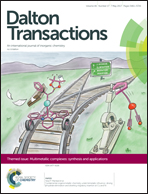Heterobimetallic complexes of palladium and platinum containing a redox-active W[SNS]2 metalloligand†
Abstract
Complexes of the general formula W[SNS]2M(dppe) (M = Pd, Pt; [SNS]H3 = bis(2-mercapto-p-tolyl)amine; dppe = 1,2-bis(diphenylphosphino)ethane) were prepared by combining the corresponding (dppe)MCl2 synthon with W[SNS]2 under reducing conditions. X-ray diffraction studies revealed the formation of a heterobimetallic complex supported by a single thiolate bridging ligand and a short metal–metal bond between the tungsten and palladium or platinum. Electrochemical and computational results show that the frontier orbitals lie predominantly on the W[SNS]2 fragment suggesting that it behaves as a redox-active metalloligand in these complexes.
![Graphical abstract: Heterobimetallic complexes of palladium and platinum containing a redox-active W[SNS]2 metalloligand](/en/Image/Get?imageInfo.ImageType=GA&imageInfo.ImageIdentifier.ManuscriptID=C6DT04451D&imageInfo.ImageIdentifier.Year=2017)
- This article is part of the themed collection: Multimetallic complexes: synthesis and applications


 Please wait while we load your content...
Please wait while we load your content...